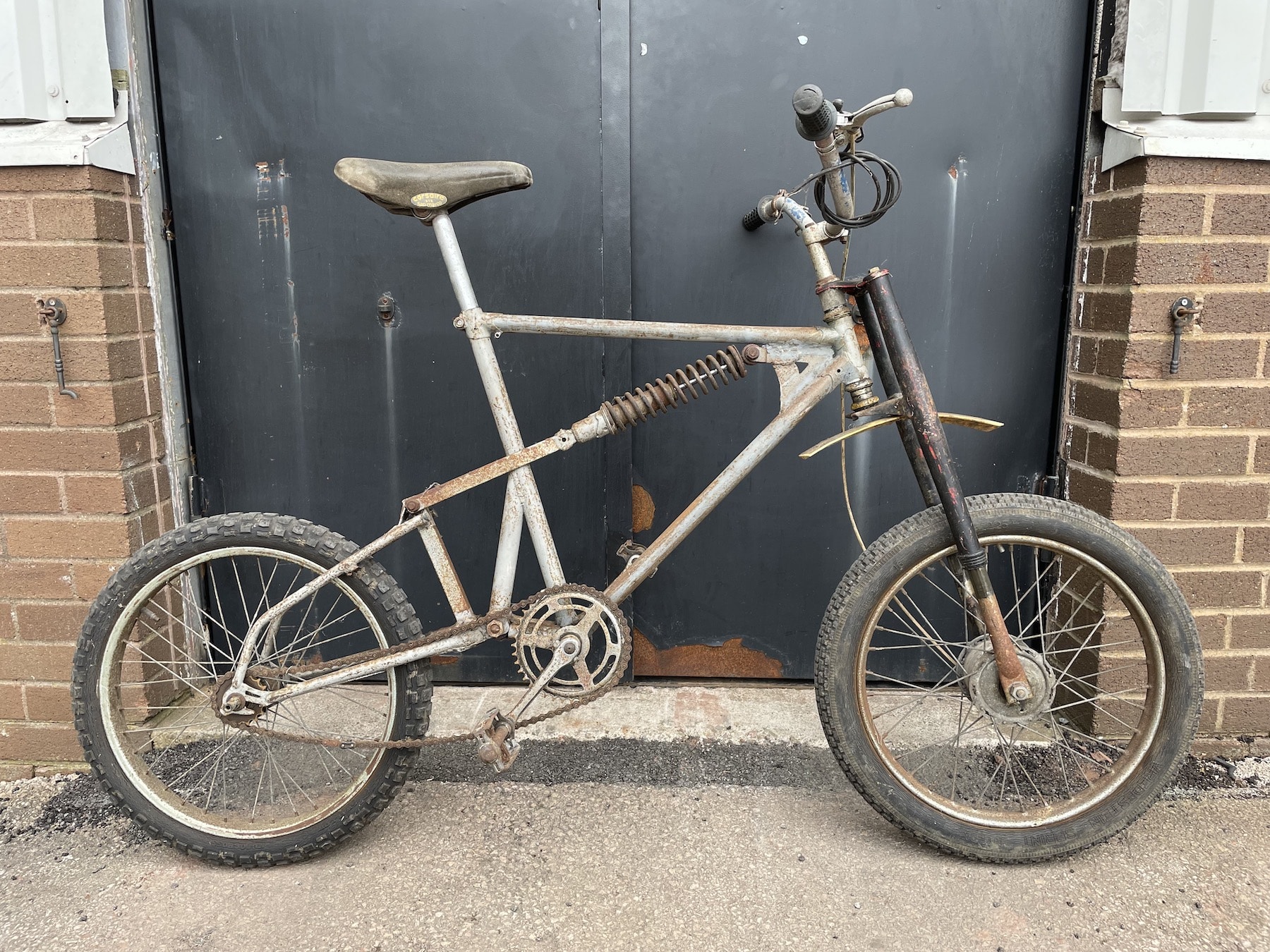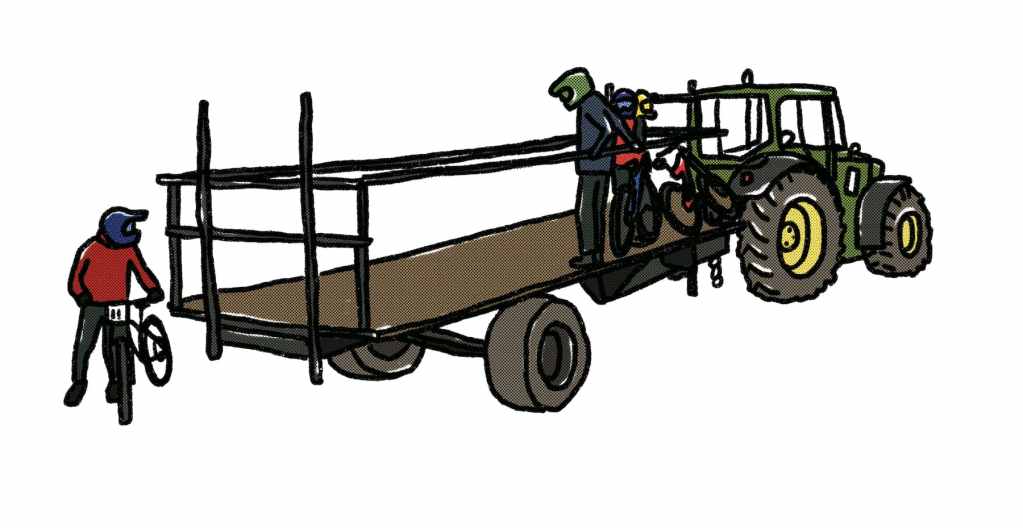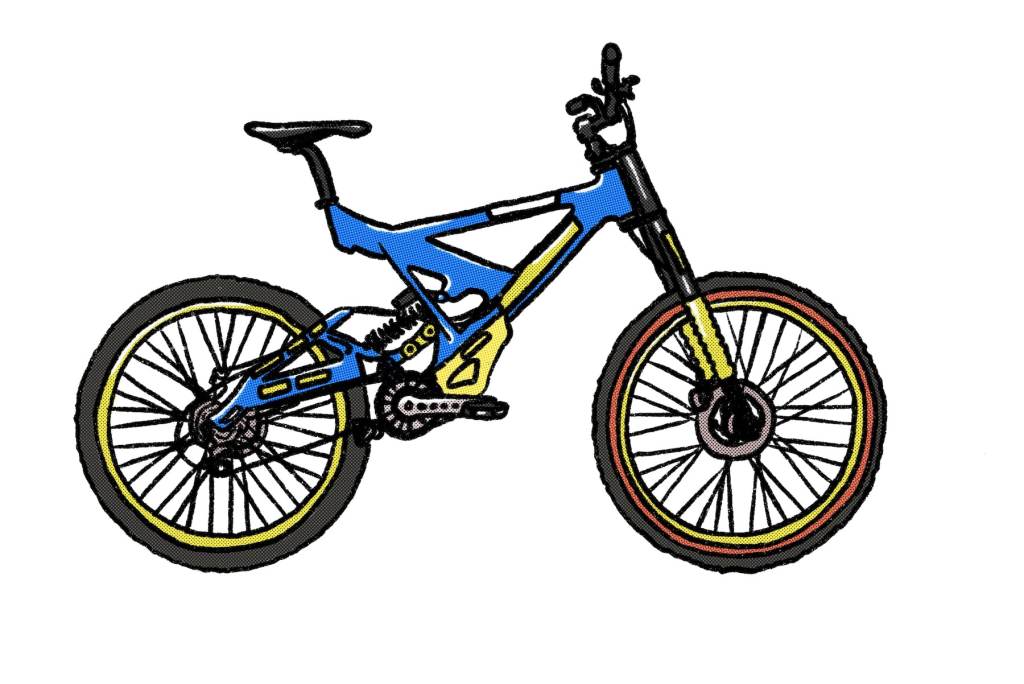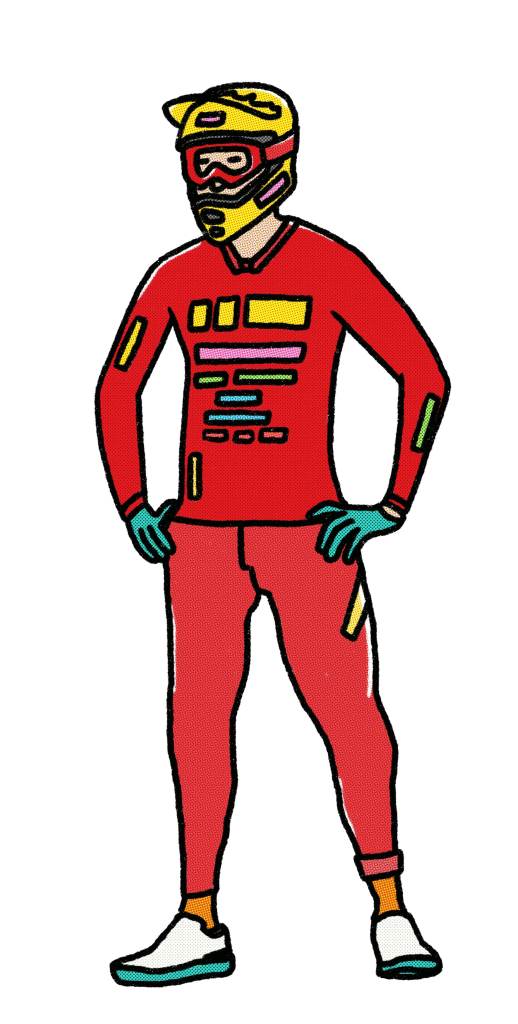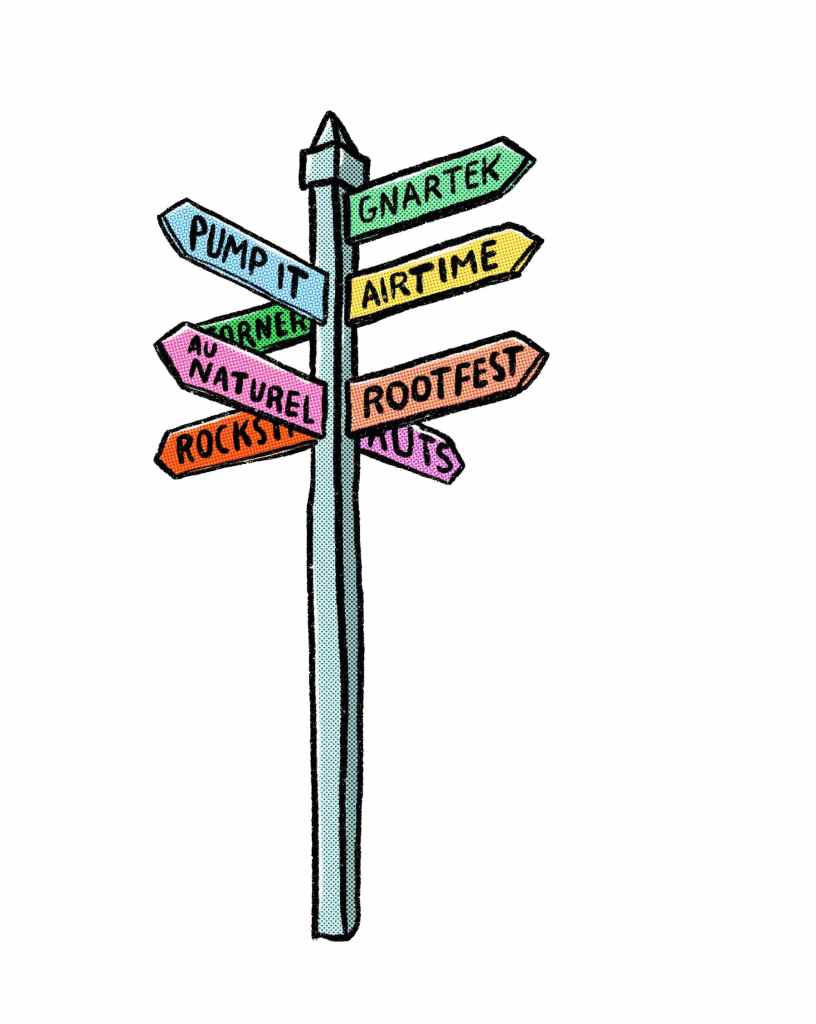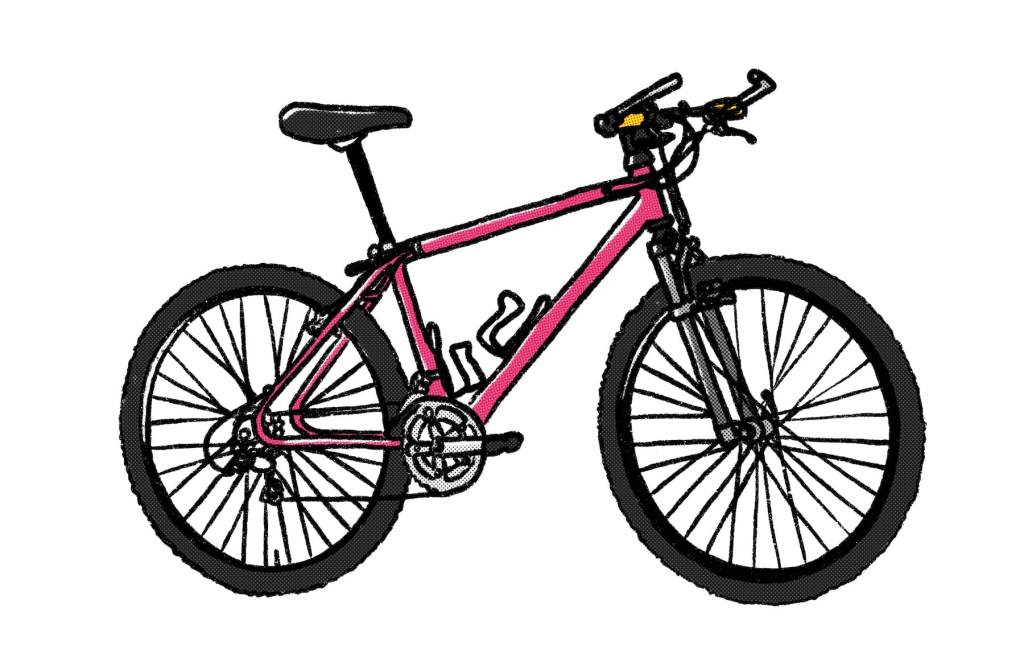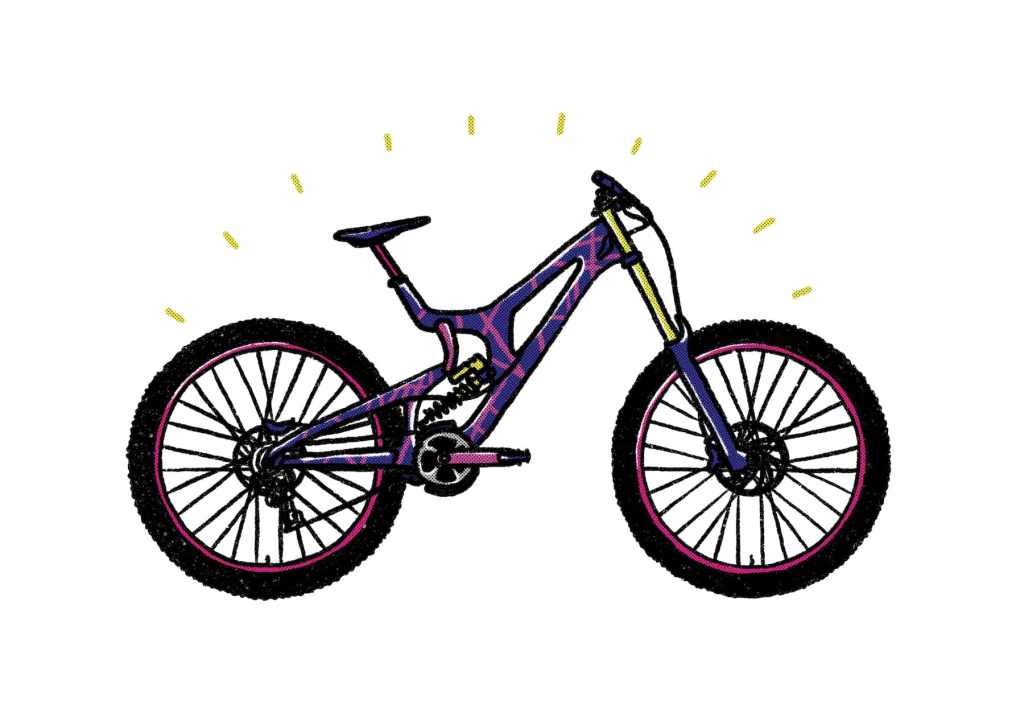VOICEOVER
DEAR DOWNHILL
Words by James McKnight. EP design by Chris Jones and Harriet Jones. Illustrations by Jon Gregory
Editor’s note: This is an extract from Downtime EP, our subscription magazine and collaboration with the excellent Downtime Podcast. The issue was published mid-2022. We hope you enjoy it. If you’d like to support what we do, consider donating or buying anything from our store. Or just telling your friends to check us out. Thank you.
PART 1: FLASHBACKS
Mountain Ash, Wales, early 2000s. I wriggle past a derailed chain hanging sadly from a crooked chainring, scuffing my scalp on a mangled, rock-bitten pedal. A rude start to the day. As I stick my head out from the putrid tent to survey the overnight rain damage, a young passer-by sticks an air rifle in my face, laughs and says he’ll get me next time (later, I see him shooting at riders as they practice).
My campsite is a rocky lump in some brambles next to the main fire road that will soon transport hundreds of avid mountain bikers to the unspectacular summit of a Welsh peak. People who are so keen to defy gravity they will gladly throw their expensive bikes in a heap at the end of a Bob Gay Plant Hire lorry and pile up alongside their steeds as the truck rumbles uphill in the pissing rain.
Arriving at the start of the Dragon Downhill course – one of the fiercest in the UK but admittedly the least intimidating of the race series’ tracks – we downhillers gather in the thick woodland to wait our turn for an attempt at a clean descent.
Small talk. Have you done the slab? Can’t see a thing in the dark mid-section. What line are you taking off the start?
Well, yes, what line indeed? The floor is writhing with blood-thirsty tree roots and painful-looking tree stumps. An obligatory boulder drop stares menacingly in my direction. My hands ache from the freezing lorry ride; my cotton hoody is soaked from yesterday.
My turn. I lower sopping googles over tired eyes and realise zero visibility before pedalling full power into a stump. The bike thuds but carries on rolling – who said heavy wasn’t innovative?
For the next five minutes I will bounce from one terrifying obstacle to the next at breakneck speeds of about 15 miles per hour, but my greatest challenge will be nursing the bike down the hill.
Lost chain, rim ding, loose bolts. All in a day’s work. Bearing explosion, blown rebound, snapped frame. Slightly more catastrophic – but not unusual. My bike, a Giant DH Team, has a brand-new front end, provided for free by an irate brand rep living a never-ending warranty nightmare. It’s the third replacement main frame; I’ve also had several rear ends and a dozen linkages.
My wheel offloads chunks of stinking mud directly onto the rear shock, which is dangerously exposed and suffering dearly. The damper is positioned somewhere between my feet, giving the bike a low centre of gravity and a high components turnover. Brown water streams down into every bearing (there are many) in the linkage assembly that dangles precariously underneath the frame, ready for yet another deadly rock strike. Grit works its way deep into the suspension.
It’s a dire situation, but we’re out here performing. Downhill is a hotbed of innovation and a true spectacle for all to see. Admittedly, there are no spectators at this race – rifle club notwithstanding – nor were there any at the one before or the one before that. And breaking stuff then bending it back into shape is research without development.
Really, we’re here for fun – an opportunity to whizz down a hillside all weekend, testing ourselves on technical terrain unlike anything we’ve ever seen and hanging out with like-minded weirdos while uncle Bob drives us back to the top.
Fort William, Scotland, 2002. It’s an exciting moment for British downhillers. Finally, international racing arrives on our shores, with the first-ever World Cup in Fort William, Scotland. Most of us know the venue – if we haven’t raced it, we’ve gawped at images in Dirt Magazine of Steve Peat, Rob Warner and Crawford Carrick-Anderson pinballing down the UK’s first world-class course during the 2001 National Points Series race. Nobody told me there’d be so many midges, but I’m thrilled to have made the pilgrimage north.
While the national scene is relatively insignificant, DH World Cup racing has been happening around the globe for a decade now. The sport had its craze moment in the 90s when it exploded into the mainstream and onto TV screens, but things have calmed down since then. Now it’s pretty core, although Dirt, Sprung and MBUK Magazine do an excellent job of making our world seem big and bright.
Ten years into DH World Cup history, and things have come an awful long way in a short time. The 90s was an era of intense activity, with bikes morphing totally during that time. Legends like John Tomac, Missy Giove, Anne-Caroline Chausson and Nicolas Vouilloz pushed the boundaries of bike and rider, helping force a rapid progression in equipment throughout mountain biking. We went from rigid frames to full suspension, cantilever to disc brakes, bar ends to riser bars.
Of course, in the 90s, there were plenty of misses to go with the hits. Despite its popularity among racers, Tioga’s Kevlar-and-plastic Disc Drive wheel disappeared into the realms of bendy-twisty-failure; the Coke-bottle-sized air canister of Shimano’s Airlines pneumatic gear shifting was deemed marginally ungainly; and motocross-inspired foot-long saddles were discovered to be unnecessary in a sport where everyone stands up.
Downhill bikes are now specialist and highly capable, and here we are, in 2002, with the world’s best racers descending on Fort William. Thousands of us fans have travelled to the Highlands to witness the stars of our sport and their futuristic machinery; before this point, we’ve only heard stories or stared at photos or watched a few VHS tapes on repeat.
Wandering around the pits, mouth agape, I stumble past the Global Racing team of all-stars, spotting Missy Giove and Greg Minnaar, two of my heroes. Across the way, Steve Peat, riding for Orange, is mobbed by worshippers. I stare into another pit and see ‘VOLVO’ emblazoned across the jerseys of Cedric Gracia and Anne-Caroline Chausson, the logo a relic of lucrative 90s sponsorship deals.
The technology on show is just something else. Chris Kovarik and Sabrina Jonnier’s factory Intense M1 bikes are stunning – beautifully formed, Ferrari red, and fast looking. Kovarik wins finals by 14 seconds, a new record margin of victory that throws the crowd into a crazed screaming fit. Wow. Downhill – what a sport.
Punta Ala, Italy, 2013. I slap another layer of sun cream on burnt arms; it will be a long day in the hills. Today marks the first-ever Enduro World Series race, an exciting new format that’s been happening in France and Italy for years but the rest of us have kind of ignored – too many detachable chin guards. With ex-World Cup downhill racer Chris Ball and a team of enduro specialists stepping up, the discipline has caught our attention.
Among the tall pines here on the shores of the Mediterranean are big team setups from the likes of SRAM, Cannondale and Santa Cruz. Peaty, Minnaar and Gracia are laughing as they mistakenly prepare for a cruisy day at the office (the smiles soon disappear).
Many people see enduro as the future; others consider it a marketing opportunity. Some think it’ll be a short-lived gimmick – downhill’s where all the exciting developments happen; things will never change, they tell themselves. Whatever the case, numerous World Cup stars are here supporting their sponsors’ current vision of progress.
The bikes are awkward looking – sort of hybrid DH-XC bikes – but you know what, this is kind of fun: pedalling around, chatting to comrades, enjoying the views, sweating a bit, sweating more, running out of sweat, cramping, crawling, crying. Luckily, we’re at the top now, and the trail ahead looks good, from what I can see through my salt-encrusted, bloodshot eyes. (This is only a practice lap trying to keep up with the pros – thankfully, I’m not racing.)
After a heavy night watching a slippery prologue stage doused by unexpected rain, I creep into the cruel sunshine as racers leave for race day. Fabien Barel, the 2004-2005 DH World Champion, and Tracy Moseley, the winner of that first-ever Fort William DH World Cup in 2002 (and just about everything winnable since), both look game.
Barel and Moseley haven’t changed since their early-2000s successes, but a lot has. Looking over the bikes, I don’t feel the same emotions seared into my soul from that 2002 Intense M1. However, this is different; slightly uneasy, but probably worth some perseverance. My beloved downhill is being elbowed off the mountain by a foreign imposter it barely understands, but deep down, I can see enduro leading us somewhere better.
Having said that, I’m beginning to think I’m more unduro than enduro. As a sign of the event’s toughness, nearly all competitors don massive backpacks containing spare helmets and enough inner tubes and chain devices for a full day out (anyone on tubeless carries spare tyres). Not what you want on your back in this heat.
Although the racing isn’t for me, I like the idea of great singletrack, a few jumps, natural terrain, and being able to pedal home without hunching over the front of a downhill bike like a crapping dog. In fact, between headaches, I have a vision that, one day, enduro will simply become mountain biking, or vice-versa.
I snap out of my daze as journalist Steve Jones, once a full-time downhill activist, rushes past at precisely 25kph. Steve’s in flip-flops and he’s forgotten his helmet, but he’s going faster uphill than the average speed of most winning DH World Cup runs. I have time only to glimpse his inane grin before he disappears over the horizon shouting ‘eeeeee’. I’d try inspecting his steed – he isn’t racing, but he’s clearly cheating anyway – but here I am, stuck rolling around helplessly in the wake of a wide-eyed man on turbo boost.
A young punk on flat pedals and massive 2.4x26in downhill tyres sticks it to most of the grownups in the race. The 16-year-old, Martin Maes, plays down his barefaced talent in a series of modest interviews. Meanwhile, Barel and Moseley take the fastest times of the day and write their names in history.
Pondering the race and the sport overall, it feels like a transitional moment in mountain biking. Rob Warner has turned up the volume on downhill racing, taking World Cup and Championships viral with enchanting one-liners like ‘look at the time’, ‘they’re going to need a lawyer for that case’, and ‘how does he sit down with balls that big?’. This has created new interest, bringing in Red Bull as the UCI’s broadcast partner. Huge audiences and social media managers want more action for viral videos, so track speed has been turned up to 11; bikes and athletes will need to adapt if they’re going to keep up.
Meanwhile, entry numbers are declining in amateur downhill races – trail riding is fun, and there are more and more places to get an uplift without entering a competition. News of the EWS has created a raft of local and regional enduros, filling a competitive void for some of the keener ex-downhillers. Where are we going next?
Les Carroz, France, 2022. I roll out the front door and put in a few power strokes as a warmup before the climb. In doing so, I graze my knee on my dropper lever and nothing happens. This should be an unremarkable detail, but it throws me straight back to years gone by, specifically a meeting of shorts and gear shifter. As I pedal uphill, the memories come flooding back:
It was in Sierra Nevada, Spain, 2007, and I was working as a cross-country guide for a holiday company, Switch-backs. My low-slung dirt jump bike was the only thing suitable for a downhiller riding not-downhill tracks – do-it-all bikes that weren’t too XC-oriented existed, but they were rare and expensive (Mike Saunders, my boss, rode a Rocky Mountain Slayer, which was in a constant state of repair). My clothing was a cotton t-shirt and some baggy shorts – standard downhiller-goes-pedalling attire at the time.
I’d been eyeing up a rock gap for a few days, but I lacked the speed each time it approached on a ride. Then one time, I got the corner before just right, got on the gas, and boom! Suddenly I was sailing through the air upside down, wondering which part of me would land on the pyramid-shaped boulder first. Once I’d detangled ribs from rock, I assessed what-the-front-flip just happened. I couldn’t work it out.
Then, a couple of years later, it happened again. Except this time, I had witnesses – a few dozen of them – all crippled with laughter. As I looked back from the floor to the start line of the Rugog Farm National Points Series race, my friends and rivals managed a few words between giggles: Did your shorts get caught on the shifter? No, actually, they got caught on the top of the BoXXer forks, throwing me violently over the bars just half a pedal stroke into another forgettable race run. But at this moment, I realised why my ribs had hurt since Spain.
It’s barely a technological revolution, but the mountain bike-specific trousers I’m wearing today are just another sign of the times. The sport is now so advanced there are different garments for every ride: enduro, trail, downhill, wet, dry, cold, hot. I’m still wearing a sweaty cotton t-shirt as a protest against modernity, but secretly I love it. Even when I wear shorts, they’ve been designed and refined and built for the task.
As if by magic, here’s the top. I’m not sure I’ll ever love pedalling up hills, but my year-2022 bike gets me there in relative contentment. My seat’s in the right place over the pedals for upwards plodding and my arms are comfortably outstretched to the handlebars thanks to the roomy cockpit.
Dropping into the trail, I sprint like it’s 2010, imagining the starting beeps of a race I never entered. I plough through the rock section, pop over some roots, send it over the hip jump and rail the turns. It’s all so easy, and so satisfying too. With only mediocre skills I get a taste of the way my heroes ride; just a decade ago, smaller wheels, almost inverted head tube angles (by today’s standards), skimpy tyres, crap suspension and cramped geometry limited this feeling to talented folk only. Crossing the finish line, I declare myself victorious – another winning ride on a modern trail-enduro-XC-DH-mountain bike.
PART 2: QUESTIONS
The recent buy-out of the broadcasting rights for the MTB World Cup by Discovery Sports (read about it in Over and Out on page 158 in EP2) got me reflecting on the changing face of mountain biking.
For the last couple of decades, downhill racing has been viewed – perhaps self-indulgingly by we downhillers, I admit – as the pinnacle of mountain biking, the discipline that has driven technological progression across the board. To some degree, racers pushing the limits at the top level have helped define the materials, components, and geometries used on all modern mountain bikes. But in an era where everyday mountain bikes bear absolutely no resemblance to downhill race bikes, what is downhill’s place in the sport?
In the early to mid-2000s, technological trickle-down was direct – Steve Peat would win on a set of next-generation RockShox BoXXer forks, then the following year anyone could go out and buy the new technology to bolt onto their downhill sled. On a consumer-testing level, every expensive broken part led to slightly better ones the next time.
Then gravity riders (for want of a better name) started pedalling to the top again. What we expected of our bikes changed. Now we wanted to ride singletrack and downhill tracks and get back to the top under our own steam. This brought up the classic weight-performance-price predicament (you can’t have low weight, high performance, and affordability – only two of the three).
Cue breakages; cue innovation. Eventually, after one or two thousand mishaps, frame materials improved, brakes got better, gear ranges wider, chains stopped falling off, and wheels mostly stopped crumpling. Dropper seatposts, in my opinion, were the greatest revolution in mountain biking since suspension and disc brakes.
I also believe EWS racing, with its restrictions on wheel and frame changes (you must use the same ones all race) and its demanding terrain, helped drive a lightspeed bout of innovation. Now, we have bikes that are relatively long-lasting (by comparison to ten years ago), we can pedal to the top on singletrack, ride gnarly descents and massive jumps if we want and still enjoy mellower trails too. Trails are more accessible thanks to bigger wheels, wider tyres, and improved angles. We got there in the end.
PART 3: PONDERINGS
Mountain biking has been my religion since 1986, and like any good disciple, the way I worship changes to suit my mood. Once I could only ever see myself as a downhill devotee, but now I barely swing a leg over a big rig – my 160mm-travel mullet is suitable for everything I ride at home in the French Alps.
I don’t race anymore, so why would I ride a DH bike when, even in Europe’s biggest mountains, it’s hard to find terrain gnarly enough to warrant it? Besides, the geometry on modern race bikes is so raked out for speed that you need to be going 50% above my ability to get it working; at my slow pace, modern downhill bikes feel kind of whack.
Maybe DH bikes are just developed so specifically for whoever is on each brand’s World Cup team that the shoes don’t fit anyone else. I spoke to a team mechanic in 2017 who described how his riders weren’t performing because their bike had been built around a previous team; the new roster of riders found it completely unrideable.
Despite never riding downhill these days, I’m still passionate about downhill racing. If anything, I am an even bigger fan than ever. World Cup coverage (full disclosure: I work freelance for Red Bull) has become polished and ever-more exciting over time. The productions have boosted the sport’s image and gained a vast audience. In my opinion, Discovery will help take this to another level again.
But, if I were 25 years younger and just discovering mountain bikes, sadly, I doubt I’d be interested in going downhill racing. There’s an exciting world out there of natural terrain, bike parks, jumps, jibs, digging, pedalling, uplifting and sped-up video clips.
I follow downhill avidly, and I am in awe of the men and women risking everything for hundredths of seconds; I love reporting from the races. But I’m sure I’ll never own another downhill bike – a bike park sled, yes, but not a bike resembling what pro racers are using.
Downhill racing is no longer a participant sport – for evidence, look at the lack of entries into races and, er, the lack of races. Little more than a decade ago, multiple regional and national events would sell out on the same weekend. Now, there is barely a national race series.
Nonetheless, World Cup racing is massive. In the future, as its reach and media output swell, will racers start to resemble Formula 1 drivers: perfect-skinned millionaire children riding for teams backed by their billionaire parents? Probably not, thankfully. I’m sure the fans will scare those sorts off – screaming chainsaw-wielding maniacs up trees don’t fit the glitzy F1 image.
I can’t tell if downhill is entering a new golden age or if it risks becoming irrelevant to most mountain bikers, an elitist sport practised on private courses (Commencal already has one for its athletes) far away from the crowds. The next generation of talent might prefer jibs and freedom rides to mortgaging parents’ houses to go racing.
PART 4: STATEMENTS
Is downhill purely sport and entertainment, or does it have any bearing on the bikes we ride? What does that mean for race bikes? Will they become more and more custom for each rider or team, resembling nothing available to the public? Does modern downhill racing influence everyday mountain bikes?
Independent bike tester and one-time-World Cup racer Paul Aston thinks downhill could have a greater impact on everyday mountain bikes. When I asked him about comparable technology in downhill and consumer bikes, he told me: ‘Trickle-down technology is a thing, but its effect has also trickled down (diminished) over the years. I think most modern mountain bikes show signs of earlier development: disc brakes, suspension, tyre-rim design, and geometry all had their boundaries pushed by the needs of riders trying to go faster down a hill to shave off seconds as much as possible.’
Aston doesn’t beat around the bush, telling me, ‘Over the last five years or so, not much has changed. I think there are enduro bikes out there now that handle better than the average DH bike and have more tech. Downhill has been stale for some time apart from making the wheels bigger and slightly improving suspension and other component design.’
When I ask Aston about standout bikes he thinks have influenced the entire sport, he mentions Orange’s rapid suspension development at the start of the millennium, Nicolas Vouilloz’s Sunn Radical, the Intense-Santa Cruz VPP linkage, and Sam Hill’s DW Link bike. He laments that Honda’s RN-01 and its derailleur-in-a-can gearbox didn’t have a lasting impact on derailleur placement. I wonder if all mountain bikes will soon have high pivots and idler pulleys?
For that matter, could consumer bikes – trail bikes, enduro bikes, whatever you call them – still take more inspiration from downhill bikes? Aston thinks so, but downhill might need to up its game first, in his view: ‘I think they could if the downhill bikes had any real innovation nowadays. [UCI rules] and the need to sell production bikes hold back a lot of development and mean DH MTB is more like the Touring Cars of bikes, not the Formula One equivalent of the car industry. F1 is a whole different level where they build pure race cars to win races; all the money comes from sponsors that aren’t trying to sell those cars to consumers: manufacturers put a lot of money in, but I assume the real money comes from selling watches, fashion, oil, and energy drinks.’
Even if downhill bikes are alien specimens only racers use, millions of eyes on televised coverage means massive marketing potential. As the sport hopefully grows with the help of Discovery’s budget and aspirations, bike brands could be shoved out the way in favour of bigger deals. Look at Tom Pidcock racing XC with oil sponsors plastered everywhere but no logos on his bike for a sign of what could be next.
Not that this would necessarily be a bad thing. Aston thinks it might open the door for downhill to go nuts, with fewer restraints on the bikes people race: ‘It would be great to see F1 style development in bikes. With fewer rules and bigger budgets, I am sure we would see technologies we desperately want in MTB evolve quickly, like a solution to derailleurs being in the wrong place, DH brakes not overheating on a DH track and tyres not holding air when you need them to.’
Perhaps the process has already started. Custom rigs already exist, and we’ll surely see more as the sport booms. World Cup racer Neko Mulally quit a factory team in 2021 to focus on a new, purpose-built bike made to his exact requirements. Doing so lets him explore suspension kinematics and balance in the bike, as he explains: ‘When you change one thing, it affects everything else. It’s always a compromise, and some things like idler pulleys and floating brake mounts can isolate certain variables, but in practice have a compromise in complexity that may or may not be worth the added complication. I’m a simple guy, and I don’t like unnecessary headaches any more than anyone else. But I’m also striving for the fastest race bike…performance [and] simplicity [are] two pretty opposite things, but removing efficiently mass-produced bikes from the equation and having no concern for industrial design makes the target easier to hit. I really enjoy this, there is a lot of strategy to it, and it is something I am interested in, so it’s a pleasure to work on.’
Despite Aston’s concerns about UCI restraints, Mulally says there are few rules on what you can and can’t do (although he jokingly notes studded tyres aren’t allowed). Will World Cup racers across the board begin using one-off bikes? Mulally says he can’t speak for big brands, but from his perspective, ‘riding on a bike that I designed to fit my body, riding style and is suited for my intended terrain perfectly takes up that 1% improvement over a stock bike that can make a big difference in racing. I do think that what works for the world’s fastest racers can also work for the average rider with proper set-up, but not the other way around. On the flip side, the race bikes you see winning today get a lot of love from race mechanics throughout the season and may not be the most hassle-free things for a summer in the bike park, so maybe there is a trade-off there. World Cup tracks set a unique benchmark for bike performance, so I think it is important to consider those courses when thinking about what these bikes are designed to do.’
THE BEST CONCLUSION IS YOUR OWN
As much as it breaks my heart to admit it, the mountain bike world doesn’t revolve around downhill racing, and it probably never has. I’ve just had the blinkers on. And maybe the motorsport comparison is simply ominous for downhill; F1 is behind the times – the world went electric years ago.
Since I started riding, everything has changed. Downhill is more like cross-country, cross-country is more like downhill, trail riding is more like enduro, enduro is more like mountain biking, and e-bikes are for real.
Cy Turner runs Cotic, a UK brand since 2002 that has never produced a downhill bike or sponsored a World Cup team. As a manufacturer that is detached from investment in downhill, I find it interesting to hear how – if – racing influences its bikes.
Turner tells me that staff at Cotic ‘follow DH racing and will often talk about particular race runs along with lots of hand waving on the Monday after a race. I would say half of us watch the live streams and are pretty into it. I wouldn’t say it influences our riding directly, apart from to inspire us to ride bikes because we get so excited by what the pros do in the races. We don’t make a DH bike, and our brand isn’t defined by racing, so it doesn’t influence us in that way.’
Turner sums up modern-day mountain biking as he describes his and his staff’s riding habits, saying his personal rides take in ’a couple of laps of the local loop in Blacka Moor on fast rocky trails on my RocketMAX [29inch, 160mm-travel enduro bike], but that’s different to Paul (our Ops Manager) who will mostly ride forest singletrack, or Richard, who splits his time between a BMX track and [technical trails]. It’s very location dependent. I expect many riders’ interpretation of MTB in 2022 involves smashing laps on an e-bike. I don’t think the trails and terrain will change all that much, but I think more people will be riding some kind of assisted bike in the future.’
Make what you will of my love letter to downhill. It’s a fantastic time to be a mountain biker – or enduro rider, or all-terrain downhill rider, or whatever.
Now go ride a bike.
Note: If you enjoyed this, find plenty more like it in Downtime EP.

